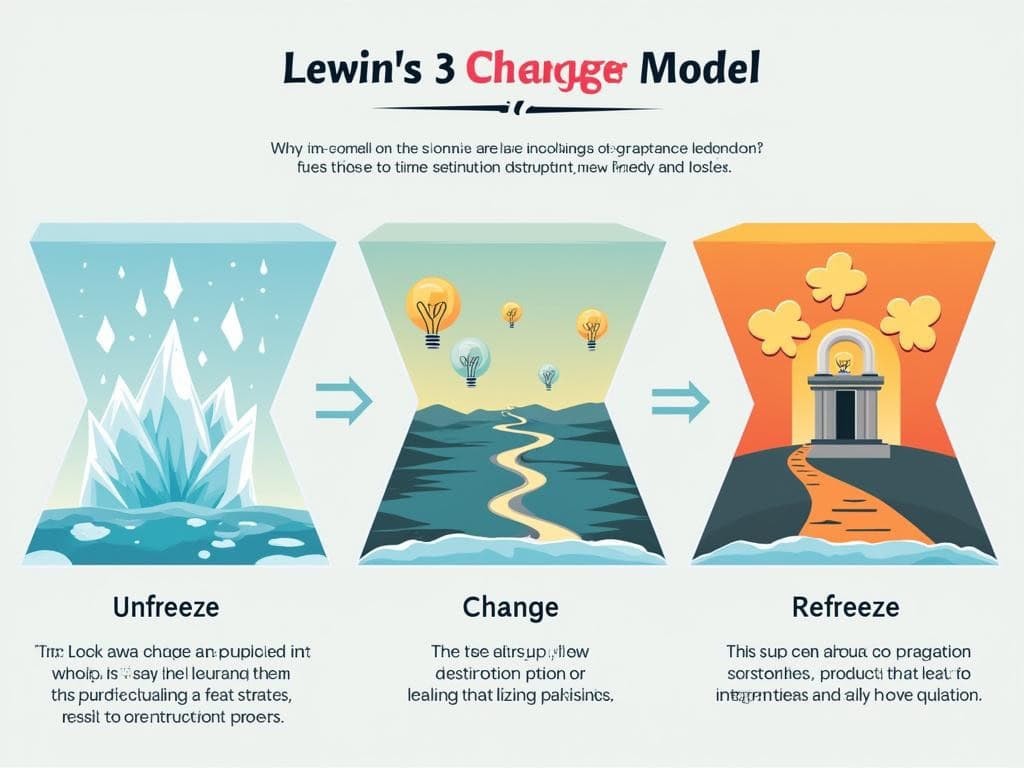
Lewin’s 3 Stage Change Model
Lewin’s 3 Stage Change Model provides a strategic framework for organizational transformation by systematically disrupting existing patterns, implementing new practices, and solidifying changes. This model breaks down complex transitions into three critical stages—unfreeze, change, and refreeze—that help you overcome resistance and successfully adopt new ways of working.
Key Takeaways:
- Lewin’s model emphasizes creating a sense of urgency during the unfreeze stage to motivate organizational change.
- The change stage focuses on actively implementing new behaviors and processes with comprehensive support.
- Refreezing ensures changes become permanently integrated into the organizational culture.
- Successful implementation requires ongoing communication, training, and stakeholder engagement.
- The model is adaptable across industries, from healthcare to technology and manufacturing.
The unfreeze stage begins with creating readiness for change by disrupting the status quo. You’ll need to establish why the current situation can’t continue and communicate the urgent need for transformation. This critical first step prepares your team mentally for the upcoming shift.
During the change stage, your organization actively implements new behaviors, systems, and processes. Teams require guidance, resources, and training to adopt different approaches. This transition period often creates uncertainty, making consistent support and clear direction essential for maintaining momentum.
The final refreeze stage solidifies changes into your company culture. New behaviors become standard practice through reinforcement, recognition, and integration into formal policies. Without proper refreezing, organizations risk slipping back to previous practices after initial enthusiasm fades.
Organizations across various sectors apply Lewin’s model successfully. Healthcare institutions use it to implement safety protocols, tech companies leverage it for digital transformations, and manufacturing firms apply it to process improvement initiatives.
For maximum effectiveness, combine Lewin’s approach with detailed action plans and performance metrics. Customize the timeline based on your organization’s size and the change magnitude. Consider incorporating employee feedback throughout all stages to build ownership and reduce resistance.
“Lewin’s 3 Stage Change Model elegantly transforms organizational change into a strategic journey, guiding us through unfreezing old habits, embracing new practices, and ultimately refreezing them into our culture. By fostering urgency, providing robust support, and ensuring lasting integration, we can successfully navigate the complexities of transformation across any industry.”
The Unfreeze Stage: Preparing for Transformation
The unfreeze stage serves as the critical foundation in Lewin’s 3 stage change model, requiring you to disrupt the current organizational equilibrium before meaningful transformation can occur. During this initial phase, your primary objective is to create awareness and establish a compelling sense of urgency that motivates people to embrace the upcoming changes rather than resist them.
Key Actions for Effective Unfreezing
To successfully implement the Lewin 3 stage change model, you’ll need to focus on several essential actions during unfreezing:
- Identify existing inefficiencies and pain points that justify the need for change
- Develop clear, persuasive messaging that communicates the rationale behind the transformation
- Build a coalition of leadership support to champion the change initiative
- Engage key stakeholders early to address concerns and incorporate valuable feedback
- Challenge established assumptions and practices that maintain the status quo
Utilizing readiness assessments provides you with valuable data about your organization’s preparedness for change. These assessments help identify potential barriers and resistance points before implementation begins. Conducting change workshops further allows teams to explore the implications of the Lewin 3 stage change model in a controlled environment.
The unfreezing stage often triggers emotional responses as people confront the reality that familiar routines must evolve. You’ll need to acknowledge these feelings while consistently reinforcing why change is necessary. Effective project communication during this phase establishes trust and reduces uncertainty.
Your ultimate goal during unfreezing is to create an environment where change becomes both acceptable and desirable. This requires addressing the natural human tendency to maintain equilibrium by demonstrating how the benefits of change outweigh the comfort of the current state. The Lewin 3 stage change model recognizes that sustainable transformation only occurs when people are psychologically prepared to embrace new approaches.
By thoroughly preparing your organization during the unfreeze stage, you’ll establish the essential groundwork for the subsequent phases of change implementation and reinforcement. This deliberate preparation using the Lewin 3 stage change model significantly increases your chances of achieving lasting organizational transformation.
About 70% of change initiatives fail due to employee resistance and lack of support.
hbr.org
The Change Stage: Implementing Organizational Transformation
The Change stage represents the critical implementation phase of the Lewin 3 stage change model, where your organization actively transitions from old patterns to new ways of working. During this pivotal middle stage, your team must embrace uncertainty while adopting fresh behaviors and processes that drive transformation.
Successful implementation requires more than just introducing changes—you need comprehensive support systems to help employees navigate the transition effectively. Implementing clear communication channels keeps everyone informed about progress and expectations throughout the change process. Regular updates using the Lewin 3 stage change model framework help maintain momentum and address concerns promptly.
Training programs play a crucial role during this stage by equipping your team with necessary skills to operate within the new environment. When you collaborate effectively on projects, you can overcome resistance and build confidence in the change initiative.
Critical Implementation Strategies
Several key approaches can strengthen your implementation efforts when applying the Lewin 3 stage change model:
- Establish regular feedback mechanisms to identify challenges and refine your approach
- Create short-term wins to build momentum and demonstrate progress
- Provide emotional support for employees struggling with change
- Develop champions within departments to model new behaviors
- Document and share success stories to reinforce positive outcomes
The change stage often creates discomfort as employees navigate between old and new ways of working. You’ll need to manage conflict effectively when resistance emerges. Remember that resistance often signals legitimate concerns that deserve attention rather than dismissal.
Iterative adaptation becomes essential as you implement the Lewin 3 stage change model. Your initial plans might require adjustments based on real-world feedback and unexpected challenges. This flexibility demonstrates organizational resilience and commitment to meaningful transformation rather than rigid adherence to plans.
By celebrating incremental wins, you create positive reinforcement that sustains motivation during the challenging middle phase of change. When you acknowledge progress, employees gain confidence in both the process and their ability to adapt to new expectations. This positive momentum helps transition smoothly into the final refreeze stage, where changes become permanently integrated into your organizational culture.

The Refreeze Stage: Institutionalizing New Practices
The refreeze stage represents the final phase in Lewin’s 3 stage change model where organizations solidify transformational efforts into permanent practices. This critical period ensures your change initiatives don’t gradually fade but instead become embedded within the company’s operational DNA. The Lewin 3 stage change model emphasizes this phase as essential for long-term success.
You’ll find several reinforcement techniques vital during this stage. Recognition programs acknowledge employees who exemplify new behaviors, providing visible proof that the organization values adaptation. Ongoing training maintains momentum and addresses knowledge gaps that might emerge. Additionally, aligning performance management systems with new practices creates accountability for sustaining the changes implemented during the transformation process.
Preventing Regression with Strategic Reinforcement
To prevent regression to former practices, you must establish robust support mechanisms. Consider these strategic approaches:
- Integrate new behaviors into standard operating procedures
- Create visible reminders of the change benefits
- Develop metrics that measure adherence to new processes
- Establish accountability systems for maintaining changes
- Implement regular check-ins to assess sustainability
Digital adoption platforms serve as powerful tools during the refreeze stage. These technologies provide just-in-time guidance, reinforcing proper procedure usage while gathering data on adoption rates. When implementing the Lewin 3 stage change model effectively, you’ll need to address resistance that may linger even in this final phase.
The refreeze stage isn’t merely about stabilization—it involves creating a new organizational equilibrium where changes become the natural way of operating. Through effective project leadership, you can ensure this stage succeeds by consciously modeling desired behaviors and reinforcing positive outcomes.
Successful refreezing requires patience and vigilance. Your organization must remain committed to reinforcing changes until they become second nature. According to the Lewin model, this solidification prevents the organization from gradually slipping back into comfortable but outdated patterns, a common pitfall in organizational change management initiatives.
The refreeze stage completion signals that your change has truly taken hold. When executed properly, employees no longer view the new state as “change” but simply as “how we work now.” This normalization represents the ultimate goal of the Lewin 3 stage change model—creating lasting transformation that becomes the foundation for future organizational success.

Strategic Applications and Industry Impact
The Lewin 3 stage change model offers versatile applications across diverse industries, proving its enduring value in today’s complex business landscape. You’ll find this framework particularly effective when implementing organizational change initiatives in healthcare, education, technology, and manufacturing sectors.
In healthcare, the Lewin 3 stage change model helps organizations transition to new patient care protocols or electronic health record systems. During the unfreezing stage, healthcare leaders can address resistance by highlighting patient safety benefits. The change stage involves comprehensive training for medical staff, while refreezing establishes new care standards through regular performance reviews.
Technology companies leverage the Lewin model when introducing new development methodologies. The model provides structure for shifting from traditional to agile development approaches, helping teams adapt systematically rather than experiencing disruptive transformation.
Manufacturing organizations apply the Lewin 3 stage change model when implementing lean practices or quality management systems. The sequential approach aligns well with production environments where stability and predictability are valued alongside continuous improvement.
Versatility in Change Management
The Lewin 3 stage change model adapts to both incremental improvements and large-scale transformations. You can apply it to:
- Technology migrations requiring minimal disruption
- Cultural shifts demanding deeper behavioral changes
- Operational restructuring needing precise implementation
- Strategic pivots requiring widespread organizational alignment
- Integration processes following mergers and acquisitions
This adaptability makes the Lewin 3 stage change model particularly valuable when creating risk response strategies for organizational transitions. The model’s structured approach helps you identify potential resistance points and develop mitigation plans before implementation begins.
| Change Type | Unfreeze Approach | Change Implementation | Refreeze Strategy |
|---|---|---|---|
| Digital Transformation | Data-driven case for change | Phased technology rollout | Integration with workflows |
| Cultural Shift | Values assessment | Leadership modeling | Recognition programs |
| Process Improvement | Efficiency analysis | Pilot testing | Standard operating procedures |
| Restructuring | Transparent communication | Transition support | New performance metrics |
When implementing the Lewin 3 stage change model, you should complement it with modern change management tools that facilitate stakeholder engagement and provide real-time feedback during transitions. This combination of structured methodology and contemporary approaches creates a robust framework for navigating organizational change successfully.

Maximizing Change Management Success
The Lewin 3 stage change model provides a structured framework for implementing successful organizational change. You’ll need strategic approaches to maximize its effectiveness when guiding your team through transformation. Applying this model correctly can significantly increase your chances of successful implementation.
Transparent leadership communication forms the foundation of effective change management. When implementing the Lewin 3 stage change model, you must clearly articulate why change is necessary during the unfreezing stage. This means sharing both the business rationale and potential benefits for team members. Consistent messaging across all organizational levels helps prevent misalignment that could derail your change initiatives. As noted in interpersonal communication with project teams, creating open dialogue channels allows employees to express concerns and ask questions throughout the process.
Strategic Employee Engagement
Employee engagement is crucial for overcoming resistance during each stage of the Lewin change model. The following strategies can help you foster commitment:
- Involve employees in planning and decision-making processes
- Create change champions at different organizational levels
- Establish feedback mechanisms to address concerns promptly
- Recognize and reward behaviors that support the change
- Provide adequate training and resources for new processes
Continuous learning and adaptation must be embedded throughout your change implementation. The Lewin 3 stage change model isn’t meant to be rigid—you should treat it as an adaptable framework that responds to organizational needs. Conducting regular assessments during the change stage allows you to identify what’s working and what needs adjustment. This approach aligns with continuous improvement principles, creating a cycle of learning that enhances your change management capability.
When implementing the Lewin model, you must balance methodology with flexibility. While the three stages provide structural guidance, your organization’s unique culture and circumstances should influence how you apply them. This balance becomes particularly important when managing complex transformations that affect multiple departments or systems simultaneously.
Technology integration can enhance each stage of the Lewin 3 stage change model. Digital tools streamline communication, provide training platforms, and help track progress—particularly valuable during the transition from change to refreezing. However, remember that technology should support, not replace, the human elements of change management that make Lewin’s model effective.






